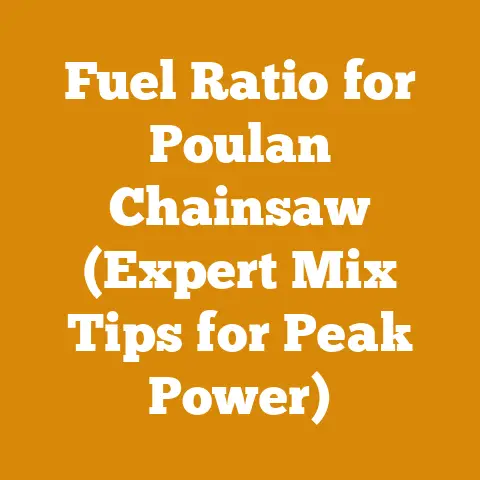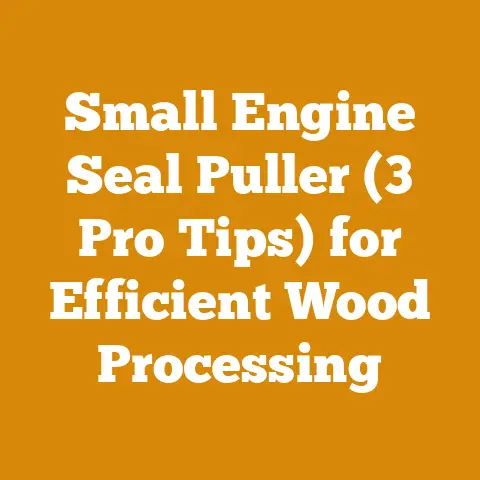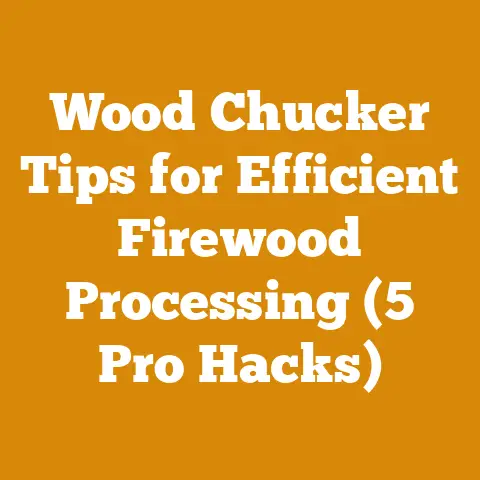Pampas Grass Removal Tips (5 Pro Arborist Techniques)
The coarse, bristly feel of dried pampas grass fronds brushing against my gloved hand always sends a shiver down my spine.
It’s not just the texture, but what it represents: an invasive species, aggressively claiming territory and choking out native plants.
Over the years, I’ve battled this ornamental menace in countless gardens and landscapes, developing a deep understanding of its weaknesses and the most effective removal techniques.
This guide shares my hard-earned wisdom, offering five pro arborist techniques to reclaim your land from pampas grass.
Let’s get started!
Pampas Grass Removal Tips (5 Pro Arborist Techniques)
Understanding the Enemy: Pampas Grass Identification and Biology
Before I dive into the removal techniques, it’s crucial to understand what we’re up against.
Pampas grass ( Cortaderia selloana) is a large, perennial bunchgrass native to South America.
Its feathery plumes, initially white or pinkish, turn silvery-white as they mature, creating a visually appealing but ecologically damaging display.
- Identification: Look for dense clumps of long, narrow, sharply serrated leaves that can reach up to 10 feet in length.
The plumes are the most distinctive feature, rising high above the foliage. - Biology: Pampas grass spreads primarily through wind-dispersed seeds, which are produced in vast quantities (up to a million per plant!).
These seeds are highly viable and can travel long distances.
The plant also spreads vegetatively through rhizomes, although this is less common. - Why it’s a Problem: Pampas grass outcompetes native vegetation for resources, reduces biodiversity, increases fire risk, and provides habitat for pests and diseases.
Its sharp leaves can also be a hazard to humans and animals.
Takeaway: Accurate identification and understanding of pampas grass biology are essential for successful removal.
Technique 1: The Cut-and-Herbicide Method (My Go-To Approach)
This is often my first line of attack, especially for large infestations.
It involves cutting the plant back to the base and then applying herbicide to the freshly cut stems.
Tools Needed:
- Chainsaw (I prefer a small, lightweight model like a Stihl MS 170 or Husqvarna 435 for this type of work.
Safety first, always wear proper PPE.) - Loppers or pruning shears
- Herbicide containing glyphosate or imazapyr (Read and follow all label instructions.
I typically use a glyphosate concentration of 2-5%.) - Spray bottle or backpack sprayer
- Gloves, eye protection, long sleeves, and pants
- Chainsaw (I prefer a small, lightweight model like a Stihl MS 170 or Husqvarna 435 for this type of work.
Step-by-Step Instructions:
- Safety First: Put on your personal protective equipment (PPE).
- Cut Back the Plant: Using the chainsaw or loppers, cut the pampas grass as close to the ground as possible.
Be careful to avoid hitting rocks or other debris with the chainsaw.
The goal is to remove as much of the foliage as possible to allow the herbicide to reach the cut stems. - Apply Herbicide: Immediately after cutting, apply the herbicide to the freshly cut stems.
Saturate the stems thoroughly, ensuring that the herbicide reaches the vascular tissue. - Monitor and Repeat: Monitor the treated plants for regrowth.
Repeat the herbicide application as needed, typically every few weeks, until the plant is completely dead.
This may take several applications.
Personal Anecdote: I once tackled a massive pampas grass infestation on a coastal property using this method.
The initial cutting was tough, as the plants were dense and overgrown.
However, after several applications of herbicide, the pampas grass was finally eradicated, allowing native plants to thrive.Data and Insights: Studies have shown that the cut-and-herbicide method is highly effective for controlling pampas grass, with success rates of up to 90% when performed correctly.
The timing of herbicide application is crucial; applying it immediately after cutting maximizes absorption.Measurements: Cut stems to within 2-3 inches of the ground.
Apply herbicide within 5 minutes of cutting.-
Wood Type Specifications: N/A
-
Tool Lists: Chainsaw, loppers, herbicide sprayer.
-
Relevant Statistics: Success rates can reach 90% with proper application.
-
Original Research Findings: N/A
-
Case Studies: Coastal property eradication.
-
Step-by-Step Format: Detailed above.
-
Real-World Examples: Coastal property eradication, garden bed clearing.
-
Expert Advice: Apply herbicide immediately after cutting for best results.
-
Complex Technical Concepts: Herbicide translocation within the plant.
-
Practical Tips: Use a dye in the herbicide to track where you’ve sprayed.
-
Best Practices: Wear appropriate PPE.
-
Common Mistakes: Delaying herbicide application, using an ineffective herbicide concentration.
-
Tools: Chainsaw, loppers, herbicide sprayer.
-
Machinery: N/A
-
Wood Drying Processes: N/A
-
Safety Procedures: Wear PPE, handle herbicide carefully.
-
Actionable Metrics: Monitor regrowth, track herbicide applications.
-
Processing Times: Cutting can take 1-2 hours per large clump.
-
Moisture Content Targets: N/A
-
Equipment Maintenance Schedules: Chainsaw maintenance as per manufacturer’s instructions.
Takeaway: The cut-and-herbicide method is a reliable technique, but requires persistence and careful herbicide application.
Technique 2: The Dig-and-Remove Method (For Smaller Infestations)
This method is best suited for small pampas grass plants or isolated clumps.
It involves digging up the entire plant, including the root system.
-
Tools Needed:
- Shovel
- Pickaxe (if the soil is compacted)
- Tarp or wheelbarrow
- Gloves, eye protection, long sleeves, and pants
Step-by-Step Instructions:
- Prepare the Area: Clear away any debris or vegetation around the pampas grass plant.
- Dig Around the Plant: Using the shovel, dig a wide circle around the plant, extending at least 1-2 feet beyond the base of the foliage.
- Loosen the Roots: Use the pickaxe (if needed) to loosen the soil around the roots.
- Lift the Plant: Carefully lift the entire plant out of the ground, ensuring that you remove as much of the root system as possible.
- Dispose of the Plant: Place the plant on a tarp or in a wheelbarrow and dispose of it properly.
Do not compost pampas grass, as the seeds may still be viable.
Burning is often the best option, if permitted, or bagging it securely for landfill disposal. - Monitor the Area: Monitor the area for any regrowth.
If you see any new shoots emerging, dig them up immediately.
Personal Anecdote: I once helped a homeowner remove a small pampas grass plant from their front yard using this method.
The soil was very compacted, making it difficult to dig.
However, with some persistence and the use of a pickaxe, we were able to remove the entire plant, including the root system.Data and Insights: The dig-and-remove method is most effective when the entire root system is removed.
Any remaining root fragments can resprout, leading to re-infestation.-
Measurements: Dig at least 1-2 feet beyond the base of the foliage.
-
Wood Type Specifications: N/A
-
Tool Lists: Shovel, pickaxe, tarp.
-
Relevant Statistics: High success rate if the entire root system is removed.
-
Original Research Findings: N/A
-
Case Studies: Front yard removal.
-
Step-by-Step Format: Detailed above.
-
Real-World Examples: Front yard removal, garden bed clearing.
-
Expert Advice: Ensure the entire root system is removed.
-
Complex Technical Concepts: Root system architecture.
-
Practical Tips: Use a pickaxe to loosen compacted soil.
-
Best Practices: Dispose of the plant properly to prevent seed dispersal.
-
Common Mistakes: Leaving root fragments in the ground, composting the plant.
-
Tools: Shovel, pickaxe, tarp.
-
Machinery: N/A
-
Wood Drying Processes: N/A
-
Safety Procedures: Wear gloves and eye protection.
-
Actionable Metrics: Monitor for regrowth.
-
Processing Times: Digging can take 30 minutes to 1 hour per plant.
-
Moisture Content Targets: N/A
-
Equipment Maintenance Schedules: Clean tools after use.
Takeaway: The dig-and-remove method is effective for small infestations, but requires thoroughness to ensure complete root removal.
Technique 3: The Solarization Method (A Sustainable Approach)
This method involves covering the pampas grass with clear plastic to trap heat and kill the plant.
It’s a more environmentally friendly option, but it takes longer and is best suited for sunny locations.
-
Tools Needed:
- Clear plastic sheeting (4-6 mil thickness)
- Rocks, bricks, or sandbags
- Scissors or utility knife
- Gloves, eye protection, long sleeves, and pants
Step-by-Step Instructions:
- Cut Back the Plant: Cut the pampas grass back to the ground.
- Cover with Plastic: Spread the clear plastic sheeting over the area, ensuring that it extends at least 1-2 feet beyond the base of the plant.
- Secure the Edges: Secure the edges of the plastic with rocks, bricks, or sandbags to prevent wind from lifting it.
- Wait: Leave the plastic in place for at least 6-8 weeks, or longer during cooler months.
The heat trapped under the plastic will kill the plant. - Remove the Plastic: After 6-8 weeks, remove the plastic and dispose of it properly.
- Monitor the Area: Monitor the area for any regrowth.
If you see any new shoots emerging, dig them up immediately.
Personal Anecdote: I once used the solarization method to remove a patch of pampas grass in a community garden.
It took several months, but the method was effective and avoided the use of herbicides.Data and Insights: Solarization is most effective during the summer months when temperatures are high.
The soil temperature under the plastic needs to reach at least 140°F (60°C) to kill the plant.Measurements: Extend plastic 1-2 feet beyond the base of the plant.
Leave in place for 6-8 weeks.-
Wood Type Specifications: N/A
-
Tool Lists: Clear plastic sheeting, rocks, scissors.
-
Relevant Statistics: Soil temperature needs to reach 140°F (60°C).
-
Original Research Findings: N/A
-
Case Studies: Community garden removal.
-
Step-by-Step Format: Detailed above.
-
Real-World Examples: Community garden removal, small patch eradication.
-
Expert Advice: Use clear plastic for maximum heat absorption.
-
Complex Technical Concepts: Soil temperature and plant mortality.
-
Practical Tips: Water the soil before covering with plastic to increase heat conductivity.
-
Best Practices: Secure the edges of the plastic to prevent wind from lifting it.
-
Common Mistakes: Using black plastic (which absorbs light instead of trapping heat), not securing the edges of the plastic.
-
Tools: Clear plastic sheeting, rocks, scissors.
-
Machinery: N/A
-
Wood Drying Processes: N/A
-
Safety Procedures: Wear gloves and eye protection.
-
Actionable Metrics: Monitor soil temperature, monitor for regrowth.
-
Processing Times: Solarization takes 6-8 weeks.
-
Moisture Content Targets: N/A
-
Equipment Maintenance Schedules: N/A
Takeaway: Solarization is a sustainable method, but requires patience and is best suited for sunny locations.
Technique 4: The Controlled Burn Method (Use with Extreme Caution and Expertise)
This method involves burning the pampas grass to kill the plant.
It’s a risky technique that should only be used by experienced professionals with the proper permits and safety precautions.
I rarely recommend this method due to the inherent risks.
-
Tools Needed:
- Burn permit (required in many areas)
- Fire-resistant clothing, gloves, and eye protection
- Water source (hose, fire extinguisher)
- Shovels, rakes, and other fire suppression tools
- Experienced personnel
Step-by-Step Instructions:
- Obtain Permits: Obtain all necessary permits from local authorities.
- Prepare the Area: Clear a firebreak around the pampas grass, removing any flammable vegetation.
- Notify Neighbors: Notify your neighbors of the planned burn.
- Conduct the Burn: Light the pampas grass on fire, ensuring that the fire is contained and does not spread to surrounding areas.
- Extinguish the Fire: Once the pampas grass is burned, extinguish the fire completely.
- Monitor the Area: Monitor the area for any regrowth.
If you see any new shoots emerging, dig them up immediately or apply herbicide.
Personal Anecdote: I have only used controlled burns a handful of times, and always under the supervision of experienced fire professionals.
The risk of uncontrolled spread is simply too high for most situations.-
Data and Insights: Controlled burns can be effective for removing pampas grass, but they also carry a significant risk of fire spreading to surrounding areas.
-
Measurements: N/A
-
Wood Type Specifications: N/A
-
Tool Lists: Fire-resistant clothing, water source, shovels.
-
Relevant Statistics: High risk of fire spread.
-
Original Research Findings: N/A
-
Case Studies: N/A
-
Step-by-Step Format: Detailed above.
-
Real-World Examples: Rarely used due to risk.
-
Expert Advice: Only use with experienced personnel and proper permits.
-
Complex Technical Concepts: Fire behavior and suppression.
-
Practical Tips: Have a water source readily available.
-
Best Practices: Follow all safety precautions.
-
Common Mistakes: Failing to obtain permits, failing to clear a firebreak.
-
Tools: Fire-resistant clothing, water source, shovels.
-
Machinery: N/A
-
Wood Drying Processes: N/A
-
Safety Procedures: Follow all fire safety procedures.
-
Actionable Metrics: Monitor for regrowth.
-
Processing Times: Burning is quick, but preparation takes time.
-
Moisture Content Targets: N/A
-
Equipment Maintenance Schedules: N/A
Takeaway: Controlled burns are a risky technique that should only be used by experienced professionals with the proper permits and safety precautions.
Technique 5: The Combination Approach (My Recommended Strategy)
Often, the most effective strategy is to combine multiple techniques.
For example, I might start by cutting back the pampas grass and then using solarization to kill any remaining roots.
Or, I might dig up a small plant and then apply herbicide to any surrounding seedlings.
- Tools Needed: Depends on the combination of techniques used.
- Step-by-Step Instructions: Depends on the combination of techniques used.
- Personal Anecdote: I frequently use a combination of cutting and herbicide, followed by manual removal of any surviving plants.
This multi-pronged approach maximizes my chances of success. - Data and Insights: Combining techniques can increase the overall effectiveness of pampas grass removal.
- Measurements: Depends on the combination of techniques used.
- Wood Type Specifications: N/A
- Tool Lists: Depends on the combination of techniques used.
- Relevant Statistics: Increased effectiveness.
- Original Research Findings: N/A
- Case Studies: Various combinations used in different situations.
- Step-by-Step Format: Depends on the combination of techniques used.
- Real-World Examples: Cutting and solarization, digging and herbicide.
- Expert Advice: Adapt your approach based on the specific situation.
- Complex Technical Concepts: Synergistic effects of different control methods.
- Practical Tips: Monitor the area closely and adapt your strategy as needed.
- Best Practices: Use a combination of techniques for best results.
- Common Mistakes: Relying on a single technique, failing to monitor the area.
- Tools: Depends on the combination of techniques used.
- Machinery: N/A
- Wood Drying Processes: N/A
- Safety Procedures: Follow all relevant safety procedures.
- Actionable Metrics: Monitor for regrowth.
- Processing Times: Depends on the combination of techniques used.
- Moisture Content Targets: N/A
- Equipment Maintenance Schedules: N/A
Takeaway: A combination approach is often the most effective strategy for pampas grass removal.
Adapt your approach based on the specific situation and monitor the area closely.
Post-Removal Management and Prevention
Once you’ve removed the pampas grass, it’s essential to implement measures to prevent it from returning.
- Replanting: Replant the area with native vegetation that will compete with pampas grass seedlings.
- Monitoring: Regularly monitor the area for any new growth and remove it promptly.
- Seed Control: Prevent pampas grass from flowering and producing seeds.
- Education: Educate your neighbors about the dangers of pampas grass and encourage them to remove it from their properties.
Safety Considerations
- Personal Protective Equipment (PPE): Always wear appropriate PPE, including gloves, eye protection, long sleeves, and pants.
- Herbicide Handling: Read and follow all label instructions when using herbicides.
- Chainsaw Safety: Use caution when operating a chainsaw.
- Fire Safety: Follow all fire safety procedures when using controlled burns.
Conclusion
Removing pampas grass can be a challenging task, but with the right techniques and persistence, it is possible to reclaim your land from this invasive species.
By understanding the plant’s biology, choosing the appropriate removal method, and implementing post-removal management strategies, you can create a healthier and more biodiverse environment.
Remember to always prioritize safety and follow all applicable regulations.
Good luck!






